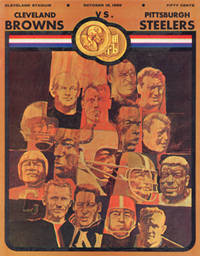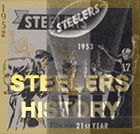
THE 1969 SQUADS
THE STEELERS
| OFFENSE: | |
|
78 Roy Jefferson |
WR |
|
74 John Brown |
WR |
|
79 Larry Gagner |
LT |
|
56 Ray Mansfied |
LG |
|
66 Bruce Van Dyke |
C |
|
77 Mike Taylor |
RG |
|
82 John Hilton |
RT |
|
89 Marshall Cropper |
TE |
|
17 Dick Shiner |
QB |
|
42 Dick Hoak |
RB |
|
38 Earl Gros |
RB |
| DEFENSE: | |
| 65 Lloyd Voss | LE |
| 75 Joe Greene | LT |
| 64 Chuck Hinton | RT |
| 60 Ben McGee | RE |
| 69 Jerry Hillebrand | LLB |
| 59 Ray May | MLB |
| 34 Andy Russell | RLB |
| 29 Bob Hohn | LCB |
| 21 Jim Schorter | RCB |
| 47 Marv Woodson | LS |
| 20 Paul Martha | RS |
THE BROWNS
|
OFFENSE: |
|
|
42 Paul Warfield |
WR |
|
77 Dick Schafrath |
LT |
|
65 John Demarie |
LG |
|
54 Fred Hoaglin |
C |
|
66 Gene Hickerson |
RG |
|
73 Monte Clark |
RT |
|
83 Charles (Chip) Glass |
TE |
|
86 Gary Collins |
WR |
|
16 Bill Nelsen |
QB |
|
44 Leroy Kelly |
RB |
|
30 Ron Johnson |
RB |
|
DEFENSE: |
|
|
88 Ron Snidow |
LE |
|
71 Walter Johnson |
LT |
|
84 Marvin Upshaw |
RT |
|
81 Jack Gregory |
RE |
|
82 Jim Houston |
LLB |
|
56 Bob Matheson |
MLB |
|
51 Dale Lindsey |
RLB |
|
40 Erich Barnes |
LCB |
|
29 Walt Sumner |
RCB |
|
24 Ernie Kellermann |
C/S |
|
34
Mike Howell |
RS |
Almost their final game at TRS
All the results from 1950 until 2000
Ten best Steelers/Browns Games
UK fans 1993 trip to Cleveland
CHUCK NOLL'S FIRST GAME AGAINST THE BROWNS
It all began on July 18, 1933. On that day, Joe Carr, the first Commissioner of the National Football League, granted a franchise to Arthur J. Rooney of Pittsburgh.
At the time, the league was suffering tremendous growing pains. It began in Canton, Ohio, in 1920 and, between then and 1933, many communities were granted franchises, operated briefly, faltered or failed, or moved on to metropolitan areas. The Chicago Bears life began as the Decatur (Illinois) Staleys.
Rooney, the oldest of a family of six boys and two girls, was only 32 years old when he became president of the Pittsburgh team. His athletic background, like that of his brothers, was rich and varied. He was such a good football player that Knute Rockne tried to persuade him to come to Notre Dame. He signed a baseball contract with the Boston Red Sox but a subsequent lame arm ended that hope. He was also a top amateur boxer.
The new franchise was named the Pittsburgh Pirates. Jap Douds, who had been an All-America player for Washington-Jefferson College, was named head coach. Rooney entered the league in what might be termed the "decade of struggle." The "Big Four" - the Chicago Bears, the New York Giants, the Green Bay Packers and the Washington Redskins dominated the play and seemingly won all the championships.
Luby DiMeolo succeeded Jap Douds as head coach and he immediately gave way to Joe Bach, one of Notre Dame's seven mules. Under Bach, the team began to make some headway but after two seasons he decided to return to college coaching.
In 1936, college coaching was a more prestigious occupation. Even though these years were not a promotional dream, Rooney signed Byron (Whizzer) White, a nationally known star from Colorado. White played only one year with the team (1938) and then went to England as a Rhodes Scholar.
Although White failed to lift the team into contention, his signing was significant. Prior to this, only a limited number of college stars joined the pros. White pioneered and thereafter almost every major college player entered the National Football League. In 1940, the struggle for survival became more intense. World War II began.
Unfortunately, the best Pittsburgh team since 1933 - the 1942 team - was decimated by the military draft. A young Virginian, Bill Dudley was the inspirational and motivational force but before the break through could be completed, Dudley was piloting B-17's in the Pacific.
Twice during the war years, Pittsburgh merged: first with the Philadelphia Eagles and then the Chicago Cardinals in order to collect enough players to stay in operation. It was at this time -1941, to be exact - the team changed its name from the Pirates to the Steelers.
In the immediate post-war era, the Steelers signed Jock Sutherland as head coach. He had a long and successful reign as head coach at the University of Pittsburgh. Spectacular results almost were immediate.
In his second season, Sutherland led his team into a divisional playoff with the Philadelphia Eagles but lost. After the season ended, the famous doctor headed south on a scouting trip. While on this trip, he was stricken ill and returned to Pittsburgh where, shortly thereafter, he died of a malignant brain tumor.
It was a damaging loss for the Steelers, Pittsburgh and for all of football. It also marked the passing of an era. Sutherland's single wing offense was phased out of pro football a few years later.
Then the Steelers joined the establishment and adopted the T-formation. The fifties and early sixties provided exciting football with Bach returning for a second stint as head coach.
He was followed by Walt Kiesling and the colorful Buddy Parker. Parker's 1963 team needed a victory in the final game against the New York Giants to give the Steelers their first Eastern Division title, but the bid fell short in Yankee Stadium.
The list is long of players who were standouts during this period. Jimmy Finks and Bobby Layne, Elbie Nickel and Buddy Dial, Ernie Stautner and "Big Daddy" Lipscomb, Jack Butler and Clendon Thomas all thrilled loyal Tri-State fans.
In 1967 the NFL and the rival American Football League entered into a merger agreement. Next season the National Football League will consist of 26 teams divided into two conferences, American and National.
The Steelers, along with Cleveland and Baltimore, will join the 10 present AFL teams to form the American Conference. Seven Steeler personalities have been elected to the Professional Football Hall of Fame. Rooney and Bell were among the first enshrined. Since then they have been joined by John "Blood" McNally, Cal Hubbard, Kies- ling, Dudley, Stautner, Layne and Marion Motley.
Chuck Noll, a young man of serious mien, entered the Steeler picture at this period. Prior to becoming a head coach, he played with the Cleveland Browns (1953-1959), spent six years as an assistant to Sid Gillman in San Diego and three years as an assistant to Don Shula in Baltimore.
As he takes the reins as the fourteenth head coach of the Steelers, Pittsburgh looks ahead to a change of fortune, a new stadium, a new conference and a new beginning.
CHUCK NOLL HEAD COACH: The Steeler position is Noll's first crack at head coaching and he brings with him a long string of successes, both as a player and a coach.
He retired from the Cleveland Browns as a player at the tender age of 27 to enter coaching. Although the opportunity that induced him to quit never materialized, he accepted a position on Sid Gillman's staff with the Los Angeles Chargers, now the San Diego Chargers, who were preparing for their initial AFL season. In six years there as chief defensive coach, the Chargers won five conference titles.
Chuck moved on to Baltimore in 1966 as defensive backfield coach under Don Shula. While he was there, the Colts boasted one of the league's best defenses and won one NFL championship.
PLAYING CAREER: A 21st draft choice in 1953, Noll played a key role on two NFL championship teams and four Eastern Conference titles in his seven seasons with the Cleveland Browns. At first, one of Paul Brown's "messenger" guards, Chuck later moved to defense as a linebacker.
As a high school player in Cleveland, Noll displayed the same versatility. Starting as a running back, he switched to tackle and became an All-State performer, earning a scholarship to the University of Dayton. He captained the Flyers and was an All-Ohio selection.
PERSONAL: Chuck was born in Cleveland, Ohio on January 5, 1932. His wife, Marianne, is a native of Portsmouth, Ohio. They have a son, Chris who is 11. The Nolls live in Upper St. Clair.
Story
taken from the programme of Chuck Noll's
first Steelers/Browns game.
